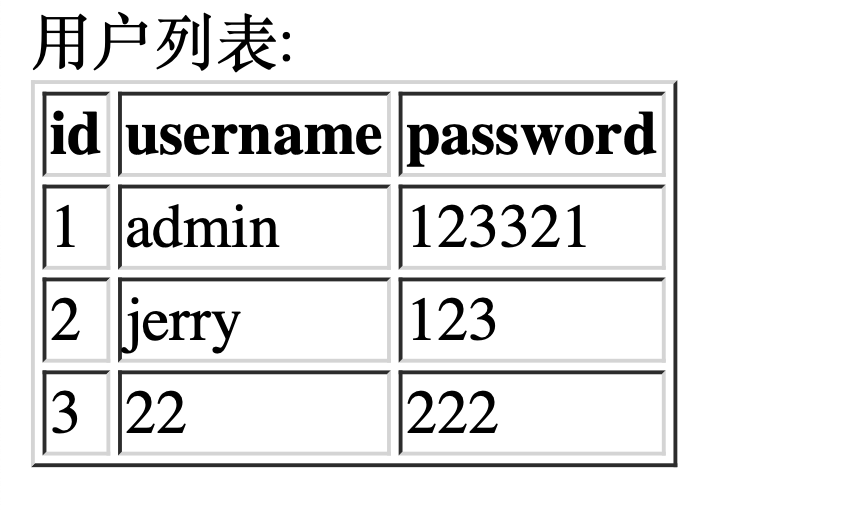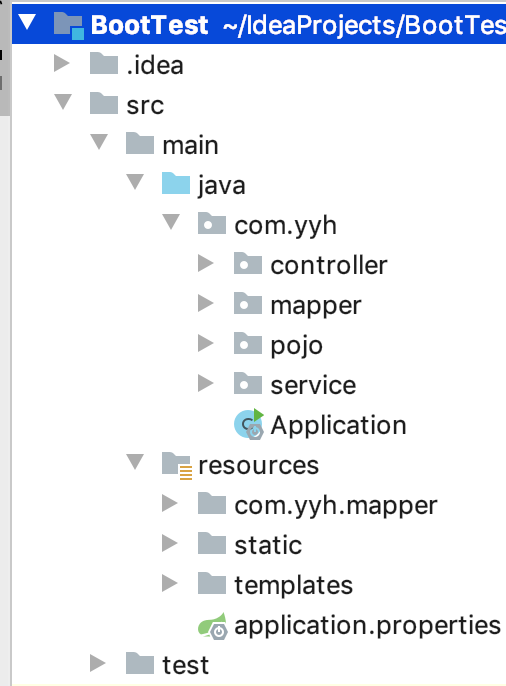SpringBoot 入门
认识Spring boot
什么是Spring boot
Spring Boot makes it easy to create stand-alone, production-grade Spring based Applications that you can "just run".
Most Spring Boot applications need minimal Spring configuration.
简单的说Springboot 是一个用于加速构建基于Spring的应用程序的框架,你可以把他叫做Spring集成框架,Spring敏捷开发框架;
Spring boot,让创建一个可用于生产级别的Spring应用程序变得非常简单,大多数Springboot应用程序需要仅最少的Spring配置。
ok,可以看得出Springboot并不是提供了某种新功能而是,将原来繁琐的框架整合变得更简单了;这样一来我们便可以专注于务逻辑的实现;
为什么需要Spring?
原因很简单了,以往在开发一个基于Spring的web项目时我们需要编写大量的配置文件,非常的耗时和低效,且容易出错,但是我们也会发现大多数应用程序的配置信息都是一样的,在这个敏捷开发大行其道的时代,Java也需要有一个能够大幅加快开发速度的框架,Spring boot应运而生, 我相信即使没有Spring boot 也会出现这样一个框架;
创建Spring-web项目过程对比
回顾一下我们以往在开发一个ssm项目时我们要做什么事情:
- 安装tomcat,用于部署最后产生的war
- 创建一个Maven项目,添加各个框架所需要的依赖包,这是还需要考虑依赖的版本兼容问题
- 创建,编写一堆看起来复杂,但又重复的配置文件,整合各个框架到Spring中
- 业务开发
- 测试-打包,发布到tomcat
Spring boot:
- 默认将tomcat打包到项目中作为默认服务器,(应用程序自己包含了tomcat)
- 创建一个Maven项目,当然你可以不创建直接去官网下载一个空项目
- 在pom中添加需要集成的框架的starter(启动器),starter会自动完成框架与Spring的整合和配置
- 一个简单的spring boot配置文件,仅需要提供少数必需的配置如jdbc参数
- 业务开发
- 直接运行main方法,或者使用maven运行,或者打包为jar 通过java -jar命令行运行
需要注意的是Spring boot 是需要依赖构建工具的,可以是maven和gradle;
Spring boot的核心功能
-
起步依赖(starter)
起步依赖本质上就是一个pom,(项目对象模型),其中包含了某个框架/功能运行所需的基础依赖信息,当我们需要某个框架/功能时加入该框架/功能的依赖即可
-
自动配置
Spring Boot会在启动时完成对各个框架的自动配置,考虑了众多因素,最终决定Spring配置应该用哪个,不该用哪个, 该过程是Spring自动完成的;
-
内置tomcat 或jetty等servlet容器
-
没有代码生成,不需要XML配置
-
尽可能自动配置Spring容器中的bean;
入门程序
案例
-
创建基础的maven过程
-
在pom中继承SpringBoot的starter,这决定了该工程是一个Spring boot工程
注意这不是依赖,而是继承关系,就像一个class一样,通过继承拥有父类的功能
<parent> <groupId>org.springframework.boot</groupId> <artifactId>spring-boot-starter-parent</artifactId> <version>2.2.4.RELEASE</version> </parent> -
在pom中添加web的starter依赖,告诉maven,web应用需要用到的依赖有哪些,只需要加进来就可以,Spring boot 将会自动完成响应的配置
<dependencies> <dependency> <groupId>org.springframework.boot</groupId> <artifactId>spring-boot-starter-web</artifactId> </dependency> </dependencies> -
编写Spring boot引导类,为spring boot提供一个启动入口
//引导类不允许放在根目录下 @SpringBootApplication public class Application { public static void main(String[] args) { //启动Spring boot 需要指定引导类 SpringApplication.run(Application.class); } } -
创建一个用于测试的controller
@RestController public class HelloController { @RequestMapping("/hello/{name}") public String helloTest(@PathVariable String name){ return "hello spring : "+name; } }此时工程目录如下:

-
运行主函数,启动应用

-
浏览器访问
http://localhost:8080/hello/aaa,tomcat默认运行在808端口,可通过控制台查看

注意:引导类不能放在根目录下;
通过maven插件来运行
maven可以帮助我们在运行前检查依赖关系
-
添加插件
<plugins> <plugin> <groupId>org.springframework.boot</groupId> <artifactId>spring-boot-maven-plugin</artifactId> </plugin> </plugins> -
maven命令
spring-boot:run
整合mybatis
添加了starter-web起步依赖后,工程就完成了Spring 和SpringMVC相关依赖和整合配置,我们已经可以处理客户端的请求并返回响应了,但是我们的数据是存储在数据库的,需要整合mybatis到项目中
添加starter和JDBC驱动
<dependency>
<groupId>org.mybatis.spring.boot</groupId>
<artifactId>mybatis-spring-boot-starter</artifactId>
<version>2.1.1</version>
</dependency>
<!--mybatis不能确定我们要链接的数据库类型 所有需要手动导入MySQL驱动-->
<dependency>
<groupId>mysql</groupId>
<artifactId>mysql-connector-java</artifactId>
</dependency>
准备数据
CREATE TABLE `user` (
`id` int(11) NOT NULL AUTO_INCREMENT,
`username` char(10) DEFAULT NULL,
`password` char(12) DEFAULT NULL,
PRIMARY KEY (`id`)
) ENGINE=InnoDB AUTO_INCREMENT=4 DEFAULT CHARSET=utf8;
INSERT INTO `user` VALUES (1,'admin','123321'),(2,'jerry','123'),(3,'22','222');
创建实体Bean
public class User {
private Integer id;
private String username;
private String password;
set/get
}
创建Mapper接口
package com.yyh.mapper;
import com.yyh.pojo.User;
import java.util.List;
@Mapper //mybatis 能识别带有该注解的mapper
public interface UserMapper {
public List<User> selectAllUser();
}
创建Mapper映射文件
<?xml version="1.0" encoding="utf-8" ?>
<!DOCTYPE mapper PUBLIC "-//mybatis.org//DTD Mapper 3.0//EN"
"http://mybatis.org/dtd/mybatis-3-mapper.dtd" >
<mapper namespace="com.yyh.mapper.UserMapper">
<select id="selectAllUser" resultType="user">
select * from user
</select>
</mapper>
测试控制器
@RestController
public class UserController {
@Autowired
private UserMapper userMapper;
@GetMapping("/user/list")
@ResponseBody
public List<User> getAllUsers(){
return userMapper.selectAllUser();
}
}
创建配置文件
在resources下创建名称为application.properties的文件,内容如下,另外spring还支持yml格式的配置文件
#DB Configuration:
spring.datasource.driverClassName=com.mysql.cj.jdbc.Driver
spring.datasource.url=jdbc:mysql://127.0.0.1:3306/boot?
serverTimezone=Asia/Shanghai
spring.datasource.username=root
spring.datasource.password=admin
#spring集成Mybatis环境
#pojo别名扫描包 mybatis.type-aliases-package=com.yyh.pojo
指定扫描mapper所在的包
若没有使用@Mapper注解需要在启动类中添加扫描包信息
@SpringBootApplication
@MapperScan("com.yyh.mapper")
public class Application {
public static void main(String[] args) {
SpringApplication.run(Application.class,args);
}
}
maven编译设置
默认情况下,maven在打包时会将java目下的*.java 以及resource下的配置文件诸如(*.xml,*.properties)等编译到target中,这个两个文件夹都属于classpath,一些人为了方便查找可能会将mapper文件和接口文件一起放在java目录下,但是maven并不会将java目录下的xml进行编译的,这时可以在pom中指定要编译的目录信息
<resources>
<resource>
<directory>src/main/java</directory>
<includes>
<include>**/*.properties</include>
<include>**/*.xml</include>
</includes>
<filtering>false</filtering>
</resource>
<resource>
<directory>src/main/resources</directory>
<includes>
<include>**/*.*</include>
</includes>
<filtering>false</filtering>
</resource>
</resources>
使用thymeleaf模板引擎
在这之前我们一直在使用jsp来作为视图层,但是jsp必须依赖servlet容器,浏览器无法直接渲染jsp文件每次开发调试想要看到最新的效果都必须重新编译jsp,所以Spring boot 并不推荐我们使用jsp,视图层可以使用模板引擎,目前主流的有thymeleaf,和freemaker,官方推荐thymeleaf;
Spring boot 提供了thymeleaf的默认配置,所以在spring boot 中使用thymeleaf非常方便,Spring boot 还设置了thymeleaf的默认视图解析器,可以像操作jsp一样来操作Thymeleaf。Controller层几乎没有任何区别,就是在模板语法上有区别。
需要强调的是:模板依然是在后端完成渲染(前后端不分离),运行流程和jsp是一样的,关于thymeleaf详细用法不是本章的重点,参见官网
添加Thymeleaf的依赖
<dependency>
<groupId>org.springframework.boot</groupId>
<artifactId>spring-boot-starter-thymeleaf</artifactId>
</dependency>
编写Thymeleaf模板
注意:模板必须放到src/main/resources/templates目录下。
<!DOCTYPE html>
<!--添加名称空间后idea可以提示补全-->
<html lang="en" xmlns:th="http://www.thymeleaf.org">
<head>
<title>user list</title>
</head>
<body> 用户列表:<br>
<table border="1">
<tr>
<th>id</th>
<th>username</th>
<th>password</th>
</tr>
<tr th:each="user:${userList}">
<td th:text="${user.id}"></td>
<td th:text="${user.username}"></td>
<td th:text="${user.password}"></td>
</tr>
</table>
</body>
</html>
Service
@Service
public class UserServiceImpl implements UserService {
@Autowired
private UserMapper mapper;
public List<User> getAall(){
return mapper.selectAllUser();
}
}
Controller
@Controller
@RequestMapping("user")
public class UserController {
@Autowired
UserService userService;
@RequestMapping("show")
public String showList(Model model) {
List<User> userList = userService.getUserList();
model.addAttribute("userList",userList);
return "index";
}
}
访问测试:
url:http://localhost:8080/user/show

热部署插件
当我们controller和service开发完毕调试视图时,热部署可以在检测到页面修改后自动重新加载,方便调试
1.添加插件依赖:
<dependency>
<groupId>org.springframework.boot</groupId>
<artifactId>spring-boot-devtools</artifactId>
<scope>runtime</scope>
</dependency>
<!--若不生效可以在build中配置fork 表示插件在独立的进程中运行-->
<plugin>
<groupId>org.springframework.boot</groupId>
<artifactId>spring-boot-maven-plugin</artifactId>
<configuration>
<fork>true</fork>
</configuration>
</plugin>
2.打开IDEA自动编译
File-Settings-Compiler-Build Project automatically
3.允许运行过程中自动生成
ctrl + shift + alt + /,选择Registry,勾上 Compiler autoMake allow when app running
静态资源访问
在SpringMVC中需要手动配置静态资源的映射关系,而Spring boot 默认以及添加了静态资源的配置,可以将静态资源请求映射到resources下的static目录
在static下放置一张图片:
|--resources
|--static
yelloman.jpg
浏览器直接访问:http://localhost:8080/yellowman.jpg
我们来看一下目前的目录结构:

这也是一个Spring boot过程基本的目录结构
Junit测试
当我们需要单独测试容器中某个bean时,从头到尾的执行一遍业务逻辑是非常耗时的,这时就可以Junit来进行单元测
添加起步依赖:
<dependency>
<groupId>org.springframework.boot</groupId>
<artifactId>spring-boot-starter-test</artifactId>
<scope>test</scope>
</dependency>
import java.util.List;
@RunWith(SpringRunner.class)
@SpringBootTest(classes = Application.class)//启动类
public class BootTest {
//注入需要测试的bean
@Autowired
UserService userService;
@Test
public void test1() {
List<User> aall = userService.getAall();
System.out.println(aall);
}
}
也可以使用SpringJUnit4ClassRunner来作为测试引擎@RunWith(SpringJUnit4ClassRunner.class)


